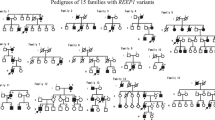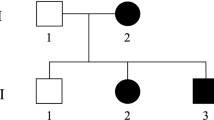Abstract
Three forms of X–linked spastic paraplegia (SPG) have been defined. One locus (SPG 1) maps to Xq28 while two clinically distinct forms map to Xq22 (SPG2). A rare X–linked dysmyelinating disorder of the central nervous system, Pelizaeus–Merzbacher disease (PMD), has also been mapped to Xq21–q22, and is caused by mutations in the proteolipid protein gene (PLP) which encodes two myelin proteins, PLP and DM20. While narrowing the genetic interval containing SPG2 in a large pedigree, we found that PLP was the closest marker to the disease locus, implicating PLP as a possible candidate gene. We have found that a point mutation (His139Tyr) in exon 3B of an affected male produces a mutant PLP but a normal DM20,and segregates with the disease (Zmax=6.63, θ=0.00). It appears, therefore, that SPG2 and PMD are allelic disorders.
This is a preview of subscription content, access via your institution
Access options
Subscribe to this journal
Receive 12 print issues and online access
$209.00 per year
only $17.42 per issue
Buy this article
- Purchase on Springer Link
- Instant access to full article PDF
Prices may be subject to local taxes which are calculated during checkout
Similar content being viewed by others
References
McKusick, V.A. Mendelian Inheritance in Man, 10th edn (Johns Hopkins 29. University Press, Baltimore, 1992).
Hudson, L.D., Puckett, C., Berndt, J., Chan, J. & Gencic, S. Mutation of the proteolipid protein gene PLP in a human X chromosome-linked disorder. Proc. natn. Acad. Sci. U.S.A 86, 8128–8131 (1989).
Gencic, S., Abuelo, D., Ambler, M. & Hudson, L.D. Pelizaeus-Merzbacher disease: an X-llnked neurologic disorder of myelin metabolism with a novel mutation in the gene encoding proteolipid protein. Am. J. hum. Genet. 45, 435–442 (1989).
Trofatter, J.A., Dlouhy, S.R., DeMeyer, W., Conneally, P.M. & Modes, M.E. Pelizaeus-Merzbacher disease: tight linkage to proteolipid protein gene exon variant. Proc. natn. Acad. Sci. U.S.A. 86, 9427–9430 (1989).
Pratt, V.M. et al. A new mutation in the proteolipid protein (PLP) gene in a German family with Pelizaeus-Merzbacher disease. Am. J. med. Genet. 38, 136–139 (1991).
Pham-Dinh, D. et al. Pelizaeus-Merzbacher disease: a valine to phenylalanine point mutation in a putative extracellular loop of myelin proteolipid. Proc. natn. Acad. Sci. U.S.A. 88, 7562–7566 (1991).
Raskind, H.W., Williams, C.A., Hudson, L.D. & Bird, T.D. Complete deletion of the proteolipid protein gene (PLP) in a family with X-linked Pelizaeus-Merzbacher disease. Am. J. hum. Genet. 49, 1355–1360 (1991).
Bridge, P.J., D'Souza, C.R. & Van Oost, B.A. A de novo Tyr206Cys mutation in the proteolipid protein gene causes Pelizaeus-Merzbacher disease. Am. J. hum. Genet. 49, 183 (5) (1991).
Doll, R., Natowicz, M.R., Schiffmann, R. & Smith, F.I. Molecular diagnostics for myelin proteolipid protein gene mutations in Pelizaeus-Merzbacher disease. Am. J. hum. Genet. 51, 161–169 (1992).
Strautnieks, S., Rutland, P., Winter, R.M., Baraitser, M. & Malcolm, S. Pelizaeus-Merzbacher disease : detection of mutations Thr181->Pro and Leu223->Pro in the proteolipid protein gene, and prenatal diagnosis. Am. J. hum. Genet. 51, 871–878 (1992).
Pratt, V.M. et al. Linkage of a new mutation in the proteolipid protein (PLP) gene to Pelizaeus-Merzbacher Disease (PMD) in a large finnish kindred. Am. J. hum. Genet. 52, 1053–1056 (1993).
Iwaki, A. et al. A missense mutation in the proteolipid protein gene responsible for Pelizaeus-Merzbacher disease in a Japanese family. Hum. molec. Genet. 2, 19–22 (1993).
Pham-Dinh, D. et al. A Pelizaeus-Merzbacher disease: a frameshift deletion/insertion event in the myelin proteolipid gene. Hum. molec. Genet. 4, 465–467 (1993).
Willard, H.F. & Riordan, J.R. Assignment of the gene for myelin proteolipid protein to the X chromosome: implications for X-linked myelin disorders. Science 230, 940–942 (1985).
Nave, K.A., Bloom, F.E. & Milner, R.J. A single nucleotide difference in the gene for myelin proteolipid protein defines jimpy mutation in mouse. J. Neurochem. 49, 1873–1877 (1987).
Merzbecher, L. Eine eigenartige familiarnereditare herkrankungsform. Z. Ges. Neurol. Psychiatr. 3, 1–138 (1910).
Boulloche, J. & Aicardi, J. Pelizaeus-Merzbacher disease: clinical and nosological study. J. child Neurol. 1, 233–239 (1986).
Harding, A.E. Classification of the hereditary ataxias and paraplegias. Lancet 1, 1151–1155 (1983).
Thurmon, T.F., Walker, B.A., Scott, C.I. & Abbott, M.H. Two kindreds with a sex-linked recessive form of spastic paraplegia. Birth Defects Orig. Art. Ser. 7, 219–221 (1971).
Zatz, M., Penha-Serrano, C. & Otto, P.A. X-linked recessive type of pure spastic paraplegia in a large pedigree: absence of detectable linkage with Xg. J. med. Genet. 13, 217–222 (1976).
Keppen, L.D. et al. Etiologioal Heterogeneity in X-linked spastic paraplegia. Am. J. hum. Genet. 41, 933–943 (1987).
Blumel, J., Evans, E.B. & Eggers, G.W.N. Hereditary cerebral palsy. A preliminary report. J. Pediat. 50, 454–458 (1957).
Johnston, A.W. & McKusick, V.A. A sex-linked recessive inheritance of spastic paraplegia. Am. J. hum. Genet. 14, 83–94 (1962).
Kenwrick, S. et al. Linkage studies of X-linked recessive spastic paraplegia using DNA probes. hum. Genet. 73, 264–266 (1986).
Goldblatt, J., Ballo, R., Sachs, B. & Moosa, A. X-linked spastic paraplegia: evidence for homogeneity with a variable phenotype. Clin. Genet. 35, 116–120 (1989).
Bonneau, D. et al. X-linked spastic paraplegia (SPG2): clinical heterogeneity at a single gene locus. J. med. Genet. 30, 381–384 (1993).
Trofatter, J.A., Pratt, V.M., Dlouhy, S.R. & Hodes, M.E. Ahall polymorphism in human X-linked proteolipid protein gene (PLP). Nucl. Acids Res. 19, 6057 (1991).
Diehl, H.J., Schaich, M., Budzinski, R.M. & Stoffel, W. Individual exons encode the integral membrane domains of human myelin proteolipid protein. Proc. natn. Acad. Sci. U.S.A. 83, 9807–9811 (1986).
Mettey, R., Hoppeler, A. & Gil, R. Transmission dans une famille sur quatre générations d'une dégénérescence neurologique se manifestant sous des aspects sémiologiques variables. J. Génét. Hum. 29, 3227–3234 (1981).
Davies, K.E., Mandel, J.L., Monaco, A.P., Nussbaum, R.L. & Willard, H.F. Report of the Committee on the Genetic Constitution of the X Chromosome. Cytogenet. cell Genet. 58, 853–966 (1991).
Barker, D.F., Cleverly, J. & Fain, P.R. Two CA-dinucleotide polymorphisms at the COL4A5 (Alport syndrome) gene in Xq22. Nucl. Acids Res. 20, 929 (1992).
Haliassos, A. et al. Modification of enzymatically amplified DNA for the detection of point mutations. Nucl. Acids Res. 17, 3606 (1989).
Apak, S.K. et al. Heterogeneity of X-linked recessive (spino) cerebellar ataxia with or without spastic diplegia. Am. J. med. Genet. 34, 155–158 (1989).
Boespflug-Tanguy, O. et al. Pelizaeus-Merzbacher disease: molecular genetic analysis in 26 families. Ann. Neurol. 30, 450–451 (1991).
Ginter, D.N., Konigsmark, B.W. & Abbott, M.H. X-linked spino-cerebellar degeneration. Birth Defects Orig. Art. Ser. X, (4) 334–336 (1974).
Dautigny, A. et al. The structural gene coding for myelin-associated proteolipid protein is mutated in jimpy mice. Nature 321, 867–875 (1986).
Gencic, S. & Hudson, L.D. Conservative amino-acid substitution in the myelin proteolipid protein jimpymsd mice. J. Neurosci. 10, 117–124 (1990).
Boison, D. & Stoffel, W. Myelin-deficient rat: a point mutation in exon III (A-> C, Thr75 -> Pro) of the myelin proteolipid protein causes dysmyelination and oligodendrocyte death. EMBO J. 8, 3295–3302 (1989).
Nadon, N.L., Duncan, I.D. & Hudson, L.D. A point mutation in the proteolipid protein gene of the shaking pup interrupts oligodendrocyte development. Development 110, 529–537 (1990).
Schneider, A. et al. Uncoupling of hypomyelination and glial cell death by a mutation in the proteolipid protein gene. Nature 358, 758–761 (1992).
Schindler, P., Luu, B., Sorokine, O., Trifitieff, E. & Van Dorsselaer, A. Developmental study of proteolipids in bovine brain: a novel proteolipid and DM-20 appear before proteolipid protein (PLP) during myelination. J. Neurochem. 55, 2079–2085 (1990).
Timsit, S.G., Bally-Cuif, L., Colman, D.R. & Zalc, B. DM20 mRNA is expressed during the embryonic development of the nervous system of the mouse. J. Neurochem. 58, 1172–1175 (1992).
Suter, U., Welcher, A.A., Snipes, G.J. Progress in the molecular understanding of hereditary peripheral neuropathies reveals new insights into the biology of the peripheral nervous system. Trends Neurosci. 16, 50–56 (1993).
La Spada, A.R., Wilson, E.M., Lubahn, D.B., Harding, A.E. & Fischbeck, K.H. Androgen receptor gene mutations in X-linked spinal and bulbar muscular atrophy. Genomics 352, 77–79 (1991).
Brown, T.R. et al. Deletion of the steroid-binding domain of the human androgen receptor gene in one family with complete androgen insensitivity syndrome: Evidence for further genetic heterogeneity in this syndrome. Proc. natn. Acad. Sci. U.S.A. 85, 8151–8155 (1988).
McClatchey, A.I. et al. Dinucleotide repeat polymorphisms at the SCN4A locus suggest allelic heterogeneity of hyperkalemic periodic paralysis and paramyotonia congonita. Am. J. hum. Genet. 50, 896–901 (1992).
Rötig, A. et al. Pearson's marrow — pancreas syndrome. A multisystem mitochondrial disorder in infancy. J. clin. Invest. 86, 1601–1608 (1990).
Schon, E.A. et al. A direct repeat is a hotspot for large-scale deletion of human mitochondrial DNA. Science 244, 346–349 (1989).
Zhang, Y. et al. A mutation in the human ryanodine receptor gene associated with central core disease. Nature Genet. 5, 46–50 (1993).
Valentijn, L.J. et al. Identical point mutations of PMP-22 in Trembler-J mouse and Charcot-Marie-Tooth disease type IA. Nature Genet. 2, 288–291 (1992).
Roa, B.B., Dyck, P.J., Marks, H.G., Chance, P.F. & Lupski, J.R. Dejerine Sottas syndrome associated with point mutation in the peripheral myelin protein 22 (PMP22) gene. Nature Genet. 5, 269–273 (1993).
Luty, J.A. et al. Five polymorphic microsatellite VNTRs on the human X chromosome. Am. J. hum. Genet. 46, 776–783 (1990).
Hazan, J., Dubay, C., Pankowiak, M.P., Becuwe, N. & Weissenbach, J. A genetic linkage map of human chromosome 20 composed entirely of microsatellite markers. Genomics 12, 183–189 (1992).
Lathrop, G.M. & Lalouel, J.M. Easy calculations of lod scores and genetic risks on small computers. Am. J. hum. Genet. 36, 460–465 (1984).
Lathrop, G.M., Lalouel, J.M., Julier, C. & Ott, J. Stategies for multilocus linkage analysis in humans. Proc. natn. Acad. Sci. U.S.A. 81, 3443–3446 (1984).
Fain, P.R. et al. Localization of the highly polymorphic microsatellite DXS456 on the genetic linkage map of the human X chromosome. Genomics 11, 1155–1157 (1991).
Huang, T.H.M., Cottingham, R.W., Ledbetter, D.H. & Zoghbi, H.Y. Genetic mapping of four dinucleotide repeat loci, DXS453, DXS4S8, DXS454, and DXS424, on the X chromosome using multiplex polymerase chain reaction. Genomics 13, 375–380 (1992).
Author information
Authors and Affiliations
Rights and permissions
About this article
Cite this article
Saugier-Veber, P., Munnich, A., Bonneau, D. et al. X–linked spastic paraplegia and Pelizaeus–Merzbacher disease are allelic disorders at the proteolipid protein locus. Nat Genet 6, 257–262 (1994). https://doi.org/10.1038/ng0394-257
Received:
Accepted:
Issue Date:
DOI: https://doi.org/10.1038/ng0394-257
This article is cited by
-
CNP deficiency causes severe hypomyelinating leukodystrophy in humans
Human Genetics (2020)
-
SPTAN1 variants as a potential cause for autosomal recessive hereditary spastic paraplegia
Journal of Human Genetics (2019)
-
Novel mutations in the GJC2 gene associated with Pelizaeus–Merzbacher-like disease
Molecular Biology Reports (2019)
-
Decreased number and increased volume with mitochondrial enlargement of cerebellar synaptic terminals in a mouse model of chronic demyelination
Medical Molecular Morphology (2018)
-
Polymorphic regulation of mitochondrial fission and fusion modifies phenotypes of microglia in neuroinflammation
Scientific Reports (2017)



